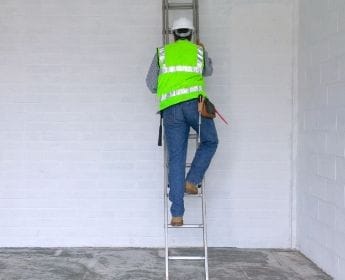When working at height under the requirements of ECO3, Anesco would like to remind you of the importance of safety when using steps and ladders, please read the following information and circulate amongst your team.
Risk assessments MUST be carried out prior to working at height and always as the question ‘is there a safer method?’.
Introduction
Use of Ladders
- Use for access or short duration work only, ensure it is suitable for the task (Class 1 or EN131) and capable of handling the load. Short duration is considered to be any work lasting no more than 20 minutes. This does not mean that you can get off of your ladder and immediately start another short duration task as you will not allow yourself to recover
- Rest ladder on a firm, non-slippery surface, at the correct angle of 1 in 4 ensure that the feet are in good condition to prevent slips
- Ensure at least 3 rungs overlap with extension ladders, extend ladder at least 1 metre above a working platform and beware of touching electrical cables, be aware that electricity can arc
- Tie ladder at the top to a secure object (ladder must be footed whilst tying and untying). If it’s not possible to tie the ladder at the top it must be footed at all times
- If the ladder would rest on guttering or any other unstable items then you must use a ladder stay
- Do not work alone at height – work in pairs
- Remove mud or grease from boots and ladder rungs before use and take one rung at a time
- Use both hands to climb a ladder. Materials must not be carried up a ladder. Only light materials (less than 10kg) should be taken up a ladder as heavy objects can cause it to topple
- Don’t Stand Higher than 1metre from the top of the ladder
- Ensure 3 points of contact with the ladder at all times (i.e. both feet and one hand)
- Use the rungs to climb and always face the ladder
- Do not lean or overstretch (reposition ladder). Use stand-offs where appropriate
- Always be conscious of the safety of those below and where possible use a barrier and/or signage
Use of Step Ladders when working at height
- Ensure steps are either Class 1 or EN131
- Check step ladder before use. If it is damaged return it to the store straight away
- Use on firm level base and don’t work higher than two-thirds up step ladder (hand-hold)
- Ensure steps are fully extended and locked before use
- Don’t lean outwards, sideways or face away from the steps – move them
- Do not use boards between treads on steps to provide a working platform
- Apply ladder safety rule above, if step ladders are more than 2m high
Inspection
- All steps and ladders must have a visual inspection by the user prior to use
- Ladders and steps must be stored correctly and regularly inspected ensuring they are free from splits or cracks in the stiles and rungs, and that none of the rungs are missing or loose. Don’t use painted ladders, as they can hide defects. Report defects and never use a defectiveladder – these must be returned to the store to be repaired or destroyed.
- Ladders and steps must be formally inspected every last six months.
Points to Remember for Utility Site Inspections
- You must have a programme of scheduled inspections for all WAH equipment
- WAH equipment must be marked with a unique reference number as part of this programme
- Users should inspect WAH equipment prior to use, and should know what to do if defective
- Users must be trained in the correct use of WAH equipment e.g. harnesses, ladder restraint kit
- To prevent dropped jobs: Do fitters have the correct WAH equipment for work to be carried out
- Ladders should never be the default option – remember the hierarchy of control for WAH
- Scaffold access ladders, hop ups and vehicle access can often be overlooked
If you require further information, please contact your business development manager or the ECO team on 0845 894 4444.
(Released 17th June 2019)






